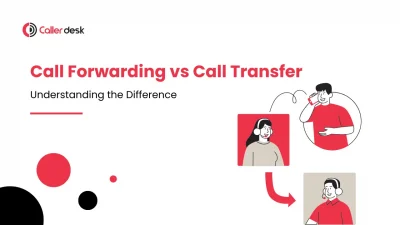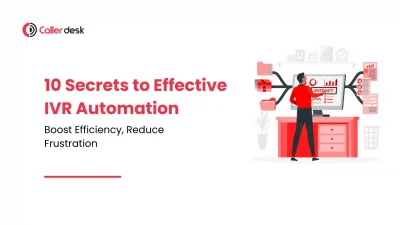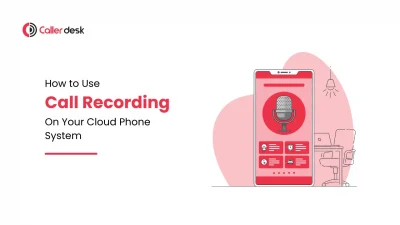Why do modern businesses need to know the differences between call centers and virtual call centers? As technology advances, businesses need to adapt their customer service strategies to stay competitive.
Traditional call centers have been the backbone of customer service for decades. They operate from a centralized location where all agents work on-site. On the other hand,Virtual call centers represent a modern approach to customer service, utilizing advanced technology to connect agents remotely.
This guide will highlight the key differences between traditional call centers and virtual call centers (VCCs), helping you decide which model best suits your business needs.
Call centers Vs Virtual Call Centers: Key differences
1. Location and Infrastructure
Traditional Call Centers
- Traditional call centers need a physical office, which means you have to pay for rent, utilities, and upkeep.
- These call centers usually occupy large buildings designed to accommodate many employees and all the necessary technology.
Virtual Call Centers
- Virtual call centers don’t require a physical office, so they cut down on rent and utility costs.
- Agents can work from anywhere, which makes it easier to expand operations.
- This setup allows businesses to save on office space and equipment since employees work remotely.
2. Technology and Tools
Call Centers
- Require physical equipment like PBX systems and dedicated servers.
- Expensive to set up and maintain.
- Need significant investment in server rooms, telephony equipment, and ongoing IT support.
- Require continuous Maintenance To ensure smooth operation.
Virtual Call Centers
- Use VoIP (Voice over Internet Protocol) and cloud-based software.
- Eliminate the need for physical infrastructure, making updates and integrations simpler.
- In comparison to traditional call centers, they are less expensive to set up and manage.
- Maintenance is done by service providers
3. Staffing and Management
Traditional Call Centers:
- Employees work in-office under direct supervision.
- Provides fixed work hours and close monitoring.
- Helps maintain high productivity and accountability.
- Challenges include higher costs and potential employee burnout due to commuting and inflexible schedules.
Virtual Call Centers:
- Staff work remotely, managed digitally.
- Offers flexible work hours, potentially boosting job satisfaction.
- Managers use software for performance tracking and communication.
- Creates an adaptable and dynamic work environment capable of responding quickly to changes in demand.
4. Cost Implications
Traditional Call Centers:
- Traditional call centers are expensive to set up and run because they need physical offices, equipment, and utilities.
- You need to spend a lot on infrastructure initially and keep paying for maintenance and utilities, making it costly.
Virtual Call Centers:
- Virtual call centers are cheaper to start and maintain because they don’t need physical offices or lots of hardware.
- They use cloud technology, which reduces both initial and ongoing expenses, making them a more affordable option.
5. Flexibility and Scalability
Traditional Call Centers:
- Traditional call centers can be rigid and slow to adapt because they rely on physical locations.
- Expanding a traditional call center is difficult and expensive since it requires more office space, new equipment, and hiring more staff, which can take a lot of time and money.
Virtual Call Centers:
- Virtual call centers are very adaptable and can quickly change in size based on what the business needs at any time.
- They can expand or reduce operations easily without needing more physical space or significant costs, making them perfect for businesses that are growing or have fluctuating customer service demands.
6. Employee Experience
Traditional Call Centers:
- Agents have fixed schedules and must commute to a physical office, which can increase stress levels.
- The office environment contributes to employee burnout and higher turnover rates due to the demands of in-person work.
Virtual Call Centers:
- Offer flexible schedules and remote work options, improving work-life balance and reducing stress.
- Employees benefit from the ability to work from home, leading to increased job satisfaction and lower turnover rates.
7. Customer Experience
Traditional Call Centers:
- Provide consistent service hours and direct interaction with agents.
- Ensures reliable customer support but may be limited by the availability of on-site staff and operating hours.
Virtual Call Centers:
- Can offer 24/7 support and access to a global talent pool.
- Utilize remote agents across different time zones, enabling businesses to provide continuous support and faster response times.
8. Security and Compliance
Traditional Call Centers:
- Controlled environments with in-house security measures safeguard customer data.
- To comply with data protection standards like GDPR and CCPA, robust cybersecurity measures are required.
Virtual Call Centers:
- To comply with data protection standards like GDPR and CCPA, robust cybersecurity measures are required.
- Secure remote access and protect customer information through advanced security protocols and regular training.
Conclusion
Understanding the differences between traditional call centers and virtual call centers is crucial for modern businesses aiming to optimize their customer service strategies. Traditional call centers offer structured environments but come with high costs and limited flexibility, whereas virtual call centers provide scalable, cost-effective solutions with remote connectivity and cloud-based technologies.
For businesses seeking enhanced operational efficiency and customer support capabilities, exploring virtual call center options, such as those offered by Caller Desk, can be necessary in achieving these goals effectively.





